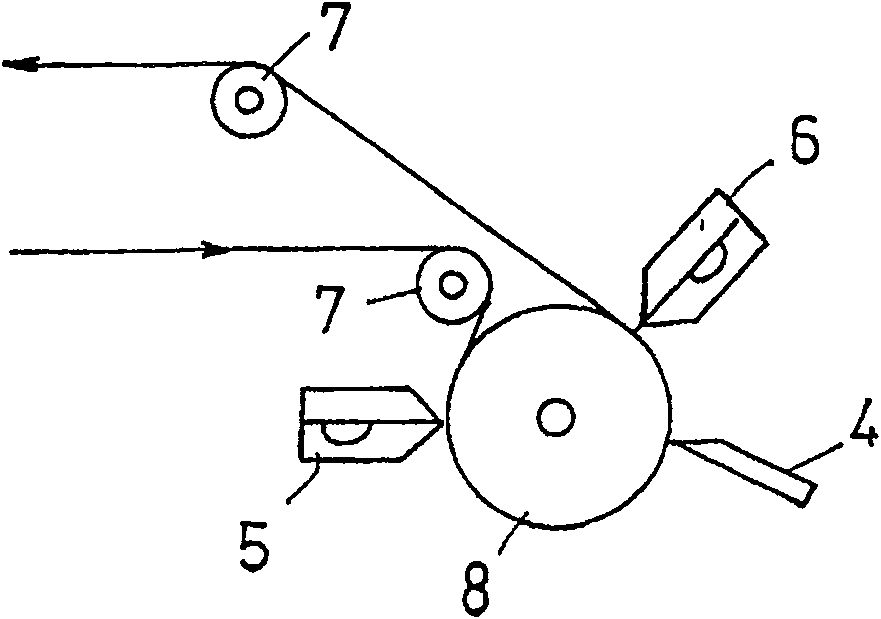Process for producing composite reverse osmosis membrane
A technology of reverse osmosis membrane and manufacturing method, applied in reverse osmosis, semi-permeable membrane separation, chemical instruments and methods, etc., can solve the problems of coating interruption, difficult acid halide concentration, uneven coating of reverse osmosis membrane, etc. Amount of usage, simplified cleaning operation, high reliability effect
- Summary
- Abstract
- Description
- Claims
- Application Information
AI Technical Summary
Problems solved by technology
Method used
Image
Examples
Embodiment 1
[0103] Prepare the aqueous solution a- 1. And organic solution b-1 (organic solvent: IP solvent) containing 0.25% by weight of trimesoyl chloride. use Figure 4 In the shown apparatus, the porous support was conveyed at a speed of 20 m / min, and the aqueous solution a-1 was coated on the porous support with a thickness of 30 μm by a slit die coater to form an aqueous solution coating layer. Thereafter, when 0.9 m was conveyed, that is, 2.7 seconds after application of the aqueous solution a-1, the aqueous solution coating layer was almost completely removed with a rubber squeegee wiper. Next, it was sent to a slit die coater installed immediately behind the blade wiper, and the organic solution b-1 was applied to a thickness of 50 μm, and was conveyed for about 2 m under room temperature atmosphere while causing interfacial polymerization reaction. Thereafter, it was sent to a drying oven at 120° C., and dried for about 30 seconds to form a polyamide-based skin layer on the p...
Embodiment 2
[0117] In addition to using Figure 5 In the shown device, the coating mechanism of the aqueous solution a-1 is specified as a micro gravure coating machine, and a composite reverse osmosis membrane is produced in the same manner as in Example 1.
[0118] A performance test was carried out on the composite reverse osmosis membrane obtained by the same method as in Example 1, and the salt rejection rate formed by the permeate conductivity was 99.84%, and the permeate flow rate was 1.64m 3 / m 2 ·day.
Embodiment 3
[0120] Prepare the aqueous solution a- 2. And organic solution b-1 (organic solvent: IP solvent) containing 0.25% by weight of trimesoyl chloride. use image 3 In the shown apparatus, the porous support was conveyed at a speed of 20 m / min, and the aqueous solution a-2 was coated on the porous support with a thickness of 40 μm by using a slit die coater to form an aqueous solution coating layer. Thereafter, when transporting 0.2 m, that is, 0.6 seconds after application of the aqueous solution a-2, the aqueous solution coating layer was substantially completely removed with an air knife (speed: 100 m / min). In addition, the weight of the support before applying the aqueous solution a-2 and the weight of the support after removing the aqueous solution coating layer with an air knife were measured, and the weight per unit area was 153.9 g / m 2 and 154.8g / m 2 , it was confirmed that the aqueous solution coating layer was substantially completely removed. Next, it is sent to a sl...
PUM
| Property | Measurement | Unit |
|---|---|---|
| surface temperature | aaaaa | aaaaa |
| thickness | aaaaa | aaaaa |
| thickness | aaaaa | aaaaa |
Abstract
Description
Claims
Application Information
 Login to View More
Login to View More - R&D
- Intellectual Property
- Life Sciences
- Materials
- Tech Scout
- Unparalleled Data Quality
- Higher Quality Content
- 60% Fewer Hallucinations
Browse by: Latest US Patents, China's latest patents, Technical Efficacy Thesaurus, Application Domain, Technology Topic, Popular Technical Reports.
© 2025 PatSnap. All rights reserved.Legal|Privacy policy|Modern Slavery Act Transparency Statement|Sitemap|About US| Contact US: help@patsnap.com



